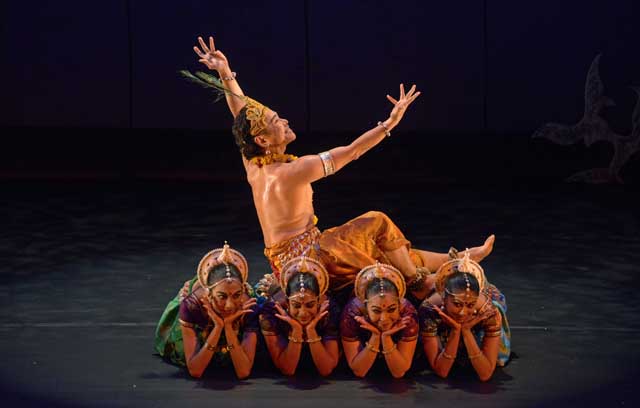
From Malaysia to India, The Gift of Dance
[dropcap]H[/dropcap]e has been Shiva and Krishna, countless mythical heroes and ordinary humans, and he has traveled the globe, telling all their wondrous tales through the magic of rhythm and dance. Datuk Ramli Ibrahim is a changemaker, an innovator with bells on his feet. For over 30 years, this Malaysian dance pioneer has nurtured both Indian classical dance and contemporary modern dance in Malaysia. He brings past, present and future on the lit up stage with audacity and shows that culture is meant to be shared, regardless of faith or nationality.
As artistic director of Sutra Dance Theater and chairman of Sutra Foundation, Ibrahim has not only taught dance to generations in Malaysia but also created awareness of culture through the language of dance in many parts of the world. Little surprise then that he has not only received a Fulbright Distinguished Artist Award, the Sangeet Natak Akademi Award, three Lifetime Achievement Awards from prestigious organizations in both Malaysia and India, but has also been acknowledged as a ‘Living Heritage’ by the Government of Malaysia.
Ramli Ibrahim in Khajuraho
[dropcap]I[/dropcap]n real life, Ibrahim is Muslim and Malaysian and yet Hindu ragas and rasas are in his soul and he has lost himself in the intricacies of Bharata Natyam and Odissi, portraying Hindu Gods across the globe. His name Ramli Ibrahim – itself a blend of different cultures – says it all. He has been a special champion of Odissi, collaborating with international performers in the east and the west.
In ancient times traders from India plying the oceans had taken spices and gold to the lands of South East Asia along with it the religions of Hinduism and Buddhism, art and culture. Even today ancient temples in these countries can be seen with sculptures of Shiva and Ganesha, Vishnu and Krishna.
In modern times, a different kind of trader has gone from India – highly qualified technology and medical workers, and they too have taken their art and culture, their Gods and their food to South Asia, including Malaysia.
Interestingly enough, it is Ibrahim, a Malaysian, who has nurtured Indian classical dance in his home country and even taken it all over the world, and back to India! Ramli Ibrahim says, “Today there are many Indians in Malaysia and Malaysia itself has had a very strong influence of India for centuries. It was known as suvarnadwipa, the golden chersonese. The individual efforts have always been very strong in sustaining and maintaining a continuity of interactive connection between India and South East Asia.”
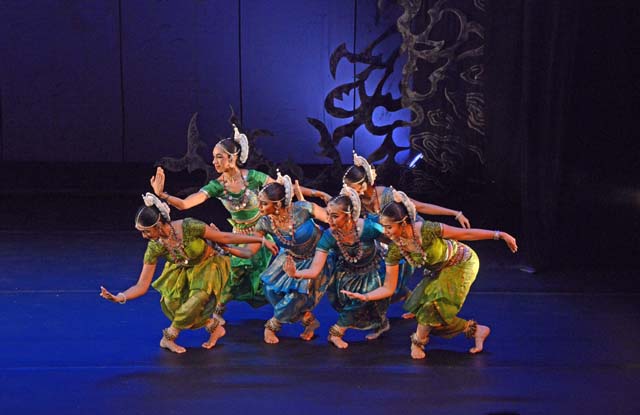
Krishna Love Re-Invented
[dropcap]I[/dropcap] met Ramli Ibrahim in New York recently where he and the Sutra Dance Company performed their new dance-drama, ‘Krishna, Love Re-Invented’ at The Asia Society. This was part of the US and Canada Tour 2014 which took him to New York, Houston and Washington DC, where the performance was at the prestigious John F. Kennedy Center for the Performing Arts, and to Edmonton in Canada.
This new production was launched at the Music Academy Dance Festival in Chennai in January of 2014 and subsequently premiered in Kuala Lumpur and toured 9 cities in Malaysia. Says Ibrahim, “Krishna, Love Re-Invented explores the ‘madhurya’ essence of love in its sweetest and honey-like appeal related to the myth of the Pastoral God Krishna, who is a personification of love. The underlying erotico-mystical spirit of love of the gopis (cowherd girls) for Krishna – unlike the darker thrust of our previous works – sends the message of joy and celebration aiming to lift the spirit under siege of many calamitous events of 2014.”
This enchanting performance of ‘bhakti’ or unconditional love is composed by Guru Debaprasad Das, Guru Gajendra K. Panda and Guru Kelucharan Mohapatra and the concept, text and artistic direction is by Ramli Ibrahim. The lighting and set design is by a core part of Sutra, Sivarajah Natarajan whose work illuminates all artistic productions by Sutra. He’s been described as “the still eye in the center of the storm, always serene.”
Sutra Foundation itself has become an important part of the art world of Malaysia. It describes itself as “striving to develop the breadth and depth of Malaysian arts through stimulating the creative spirit of cross-cultural Malaysia. Various cultures come together here to forge a unique ‘sutra’ bond that fosters a universal yet distinctively Malaysian interpretation of the arts.”
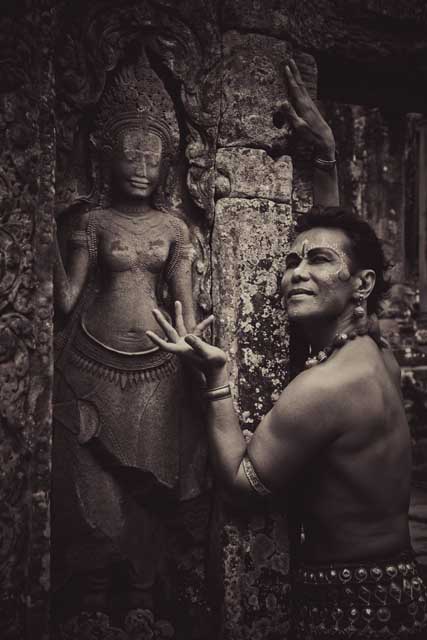
A Life of Dance
[dropcap]A[/dropcap]lthough Ibrahim has been dancing since childhood, it did not seem that it could become his life’s work. He recalls, “There was a time when South East Asian countries were concentrating on development and industry and everyone wanted to be an engineer or a doctor and nobody wanted to be in the arts. So in Malaysia it was the same thing and I was in a way a victim of this. I was good at school but I was temperamentally artistically inclined, but was pushed into the science stream and I was in fact put in a military college.”
Ibrahim later attended University of Western Australia, Perth but as he says, “By that time I knew what I wanted to do in life – I needed to follow my bliss. So I pursued this path which was in the arts, specifically dance, because even as a child, I knew I was a mover.”
Ibrahim learned ballet and modern dance but he says, “At the same time I was very interested in Asian civilizations, the myths, and all those kind of things joined together for me to look back again to Asia, and look back again to India as the mother country for South East Asia.”
He was looking for solo dances which could really challenge him. He was already a Bharata Natyam dancer but Odissi seemed to call to him. He says, “Being a Malay Muslim doing Indian dance, I knew I had to be better than others to succeed and get the accolades of connoisseurs in India.” Indian classical dancing is very challenging and difficult and he feels he’s been blessed to get the chance to dance in India in the 16th century Purana Quila in Delhi and the fabled temples of Khajuraho, where he was Invited by the Khajuraho Dance Festival Committee to perform with the world’s best.
[dropcap]I[/dropcap]brahim has an affinity towards Odissi as taught by the late Deba Prasad Das, as he told Uttara Asha Coorlawalla in an interview at the Asia Society: “Though I was exposed to the Kelucharan Mohapatra style of Odissi dance, I felt a more natural attraction to the style and composition of the late Deba Prasad Das, which thematically tends to focus on Shaivite and tantric concepts and practices. This is not to say that there is no Krishna item in Deba Prasad repertoire — the production we are bringing to New York pays homage to Krishna — a Vaishnavite theme. However, most of the works we perform from the Deba Prasad repertoire are usually Shaivite. Throughout the Odissi dance world, the Kelucharan Mohapatra style of Odissi is dominant. But Malaysia is a unique spot in the world where the Deba Prasad style of Odissi flourishes.”
Through the Sutra Foundation, Ibrahim presents a uniquely Malaysian interpretation of the arts. While the Sutra Dance Theater presents vibrant dance, the Sutra Gallery showcases the work of visual artists and the Amphi-Sutra is a stage where performers showcase their talents. Over the years Sutra has nurtured and presented many dancers and choreographers. As Ibrahim puts it, “The Sutra Foundation is an offering of the creative spirit that transcends all boundaries. It is a gift of the highest love to Malaysia.”
A Kaleidoscope of Dance Tales from Sutra Dance Theater
[dropcap]I[/dropcap]t is also about his love for India and about how he’s managed to meld a cultural embrace between the two countries. When I met him in New York, he handed me a video of Sutra in India, during the 2003 Khajuraho Festival Performance Tour. In this breathtaking video, you see Ramli Ibrahim as a son of India dancing amidst the fabulous ancient temples where Indian classical dance itself began. In this very watchable video he is seen on his travels in India, with his students cross-country by train, and involved in rehearsals and the daily life of a traveling dancer.
As he points out, with Sutra, he is involved in education and outreach programs to also connect with the less privileged communities. While he keeps the flame of classical dance alive, he does not forget his roots of ballet and modern dance at Sutra. He embraces movement in all its forms and has performed with many cultural organizations, including the Malaysian Philharmonic Orchestra where he choreographed over 20 dances featuring the music of Ravel and Stravinsky.
“Sutra believes that contemporary Asian modern dance is a continuum of the traditional and both the traditional and modern can exist under the same time and space, same roof,” he says. “How much more exciting and richer if the contemporary is also repository of all three genres – classical, folk and tribal representing the sum total of our past heritage.”
In that spirit, he has collaborated with the Battery Dance Company, a bastion of American contemporary dance led by Jonathan Hollander, and is always open to international collaborations and varied genres.
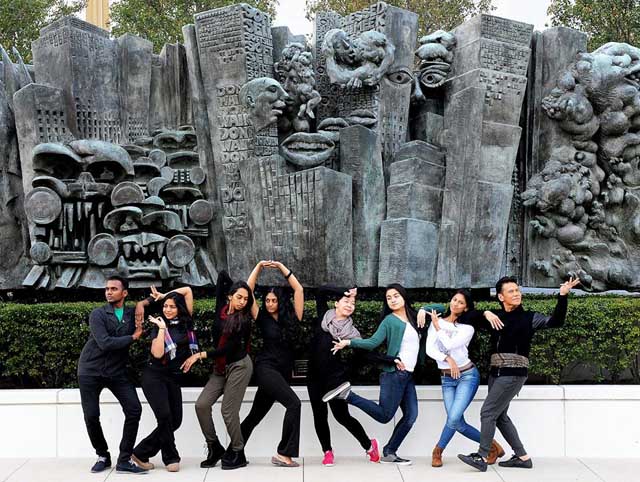
[dropcap]A[/dropcap]fter the spellbinding performance of Krishna, Love Re-invented at The Asia Society, I met with many of his friendly vibrant dancers, still in costume, beautifully made up and bejeweled. They were Indian, Malayan, Chinese – all reminders of the diverse nature of Malaysian society. Ibrahim, who calls himself a thinking Muslim, does not believe there should be any religious taboos against dancing.
“This is the 21st century – if you still want to live in medieval times then what can we say?”, he counters. ” Some people give Islam a bad name but I think I differentiate between spirituality and ritualized religion, because I think a lot of my dancers understand the inner strength and energy that comes from a good performance and this is also a basis and essence of spirituality with regards to your art form. I mean, if we are very lucky we become Balasaraswati but at least even a little bit of that will be good!”
One has to particularly commend Ramli Ibrahim for his encouragement of young male dancers, and by the example of his own life, making the profession of a male dancer something to aspire to. In a world where this profession seems to be on the decline, Ibrahim gives it wings.
[dropcap]S[/dropcap]utra Foundation and the Natyanjali Trust from India presented the dance drama Joined in Dance and also hosted the Nartaka (Male Dancer) Festival in Kuala Lumpur in 2012. As the Indian high commissioner of India to Malaysia, Vijay K. Gokhale noted, “The great artistic traditions of India are worth preserving for the future generations if Indians are to understand their cultural origins. Those who have witnessed the great dance maestros of India perform the role of Krishna in the Ras Lila or Shiva’s Tandava Nritya will know that it would be an irredeemable loss to civilization if male dancers were to disappear from the stage.”
That festival featured three days of solos and group works in Indian classical dance styles and had a discourse on Male Matters. Ramli Ibrahim and Shanmuga Sundaram, artistic co-directors of the festival noted that the goal was to demonstrate that male dancing can be exciting, beautiful and worth cultivating. As they observed, “Males should discover once again that dance is the most natural and healthiest way to integrate their outer and inner ‘landscapes’ so that, psychically and emotionally, they resonate with their nature as well as with others.”
Ramli Ibrahim himself has given many dazzling performances, particularly of Lord Shiva’s Tandava Nritya. He says, “The concept of Shiva as Lord of Dance opens up new vistas of meanings for me and as a dancer I feel that is very satisfying and a celebration of my own being.”
Ibrahim is constantly traveling and when I spoke to him he was on his way to Ahmadabad to perform with the noted dancer Mallika Sarabhai and then on to Vadora and Bhubaneshwar for many more performances. He adds, “So actually there is an incredible cultural flow now, globally there is a cultural flow. Sometimes people like me go to the Orissa temples to study much, much more than an Orissan dancer who takes it so much for granted!”
India, Always on the Map
[dropcap]I[/dropcap]ndia is always on the map for Ibrahim, to connect with his teachers, to perform to live music and interact with Indian audiences. He feels it is trial by fire for his dancers, a voyage of discovery for them as dancers. He says, “It’s very important to connect with earth – mother earth – Mother India itself. Somehow the rasa comes much more for me in India. I find the experience very cleansing for me. I think my dancers understand dance and human relationships much better after performing in India. I find it makes them into better dancers faster by bringing them to India.”
Ramli Ibrahim has come a long way from his childhood when his family had wanted him to be an engineer, and dance could not be anything more than a time-pass. It has gone on to dominate his life and that of so many others, especially young people finding their place in the world.
He thinks the arts are the best answer to a lot of the problems in the world.
“I really think that the arts contribute to incredible nation building and character building,” he says. ” There is a lot of empowerment of the individual that comes from exposure to culture and the arts, a lot of understanding. This is an antidote to the present extremist absolutism and dogma that is infecting the world at the moment. I am sure education in the arts makes people civilized!”
When Ramli Ibrahim and his dancers are on stage, you forget all else but the magic of movement and music, of ancient and modern tales coming alive. As he says, “Dance is ephemeral! You cannot own it like a painting, for the glimpse of beauty or truth – whatever you call it – is fleeting. Yet the dance experience is intense and transformative if you are lucky to see something extraordinary.”
It is Ramli Ibrahim’s life work to give you those extraordinary moments which can transform and enrich and make the world a happier, calmer place.
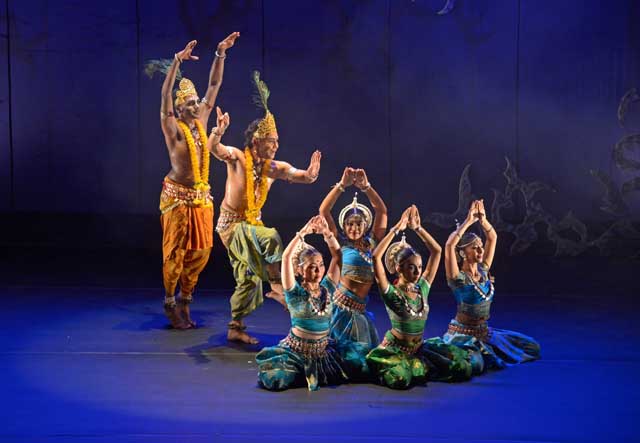
Krishna – Love Re-Invented
[dropcap]I[/dropcap]n India, romantic love in its sublimated form took a definite turn with the bhakti (devotion) movement when the concept of God was incorporated and entwined in this human obsession. As the ultimate Universal Lover, he becomes the paramount object of devotion and of romantic love. And this came about most intensely during medieval times when saint poets expressed their spiritual outpourings in the form of erotico-mystical poetry, which became viral as they resonated with the sentiment of the common folks. Love poems dedicated to the Gods were incorporated in the rituals of worship.
In Odisha, the land of Odissi, to speak of Krishna is to speak of the most familiar and beloved of the Hindu Gods. For centuries, the spirit of Krishna has permeated the very fabric of life of the Oriyan people, coloring and designing its filigreed motif, cutting across all sections of the community, gender, age and walks of life. His pervasive spirit – Krishna Consciousness as the Supreme God – is incorporated into the concept of ‘Jagannath’ , the presiding deity of the holy city of Puri.”
(Text: Sutra Foundation)
(c) Lavina Melwani. This article first appeared in Hinduism Today

1 Comment
via
Google + 12
Jasavant G +1’d
savita patole +1’d
ashritha pg +1’d
Akshay Sunil +1’d
KHAN BOBY +1’d
raviarjun@90gmail.com Ravipandit +1’d
Artist Prakhar Sharma +1’d
Sc Soundiram +1’d
arti patel +1’d
Sunil Yadav +1’d
മഹേഷ് മാധവൻ മല്ലിശ്ശേരി. +1’d
S. Kaushik +1’d